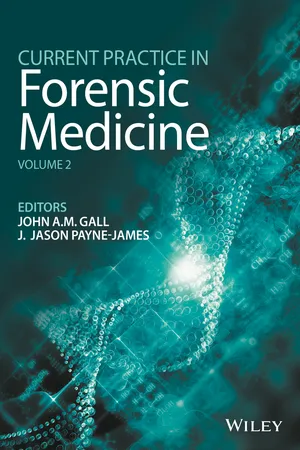
Current Practice in Forensic Medicine, Volume 2
- English
- ePUB (mobile friendly)
- Available on iOS & Android
Current Practice in Forensic Medicine, Volume 2
About this book
Forensic medicine is a broad and evolving field with areas of rapid progress embracing both clinical and pathological aspects of practice, in which there may be considerable overlap. This is the second volume in a series that provides a unique, in-depth and critical update on selected topics of direct relevance to those practising in the field of clinical forensic medicine and related areas including lawyers, police, medical practitioners, forensic scientists, and students.
The chapters endeavour to maintain a relevance to an international, multi-professional audience and include chapters on:
- DNA decontamination,
- The toxicity of novel psychoactive substances,
- The relevance of gastric contents in the timing of death,
- The effects of controlled energy devices,
- The main risk factors for driving impairment,
- The risk factors for harm to health of detainees in short-term custody,
- Autoerotic deaths,
- Child maltreatment and neglect, and
- The investigation of potential non-accidental head injury in children.
Also included are chapters on excited delirium syndrome, automatism and personality disorders. Two topics not generally covered in standard clinical forensic medical textbooks include a forensic anthropological approach to body recovery in potential crimes against humanity and risk management and security issues for the forensic practitioner investigating potential crimes against humanity in a foreign country.
Frequently asked questions
- Essential is ideal for learners and professionals who enjoy exploring a wide range of subjects. Access the Essential Library with 800,000+ trusted titles and best-sellers across business, personal growth, and the humanities. Includes unlimited reading time and Standard Read Aloud voice.
- Complete: Perfect for advanced learners and researchers needing full, unrestricted access. Unlock 1.4M+ books across hundreds of subjects, including academic and specialized titles. The Complete Plan also includes advanced features like Premium Read Aloud and Research Assistant.
Please note we cannot support devices running on iOS 13 and Android 7 or earlier. Learn more about using the app.
Information
1
DNA contamination – a pragmatic clinical view
Contamination considerations
The ‘Phantom of Heilbronn’
What we need to avoid is the assumption that the producer of the traces is automatically the culprit. Judges tend to be so blinded by the shiny, seemingly perfect evidence of DNA traces that they sometimes ignore the whole picture. DNA evidence on a crime scene says nothing about how it got there. There is good reason for not permitting convictions on the basis of DNA circumstantial evidence alone.
The Jama case
Not only was the evidence against him [Mr Jama] ultimately revealed as inherently unreliable but, it came to be recognized, the likelihood that he had committed the offence allegedly was, at the risk of understatement, remote and found to have been perpetrated in circumstances where it seemed to be highly improbable that there was any crime at all.
In other words, the DNA evidence was, like Ozymandias’ broken statue in the poem by Shelley, found isolated in a vast desert. And like the inscription on the statue’s pedestal, everything around it belied the truth of its assertion. The statue, of course, would be seen by any reasonably perceptive observer, and viewed in its surroundings, as a shattered monument to an arrogance that now mocked itself. By contrast, the DNA evidence appears to have been viewed as possessing an almost mystical infallibility that enabled its surroundings to be disregarded. … After following this history of the proceedings against the unfortunate Mr Jama from their origins through to their disastrous conclusion of his conviction, I have been left with the deep impression that at virtually every point, and by almost everyone involved, it was handled with so little insight into the issues which it presented that no need was seen to explore further or conduct research into them. This was particularly so in the case of those involved in the legal processes. There were ample warning signs along the way that suggested that something was amiss but they were simply not read.
Table of contents
- Cover
- Title Page
- Table of Contents
- List of Contributors
- Preface
- 1 DNA contamination – a pragmatic clinical view
- 2 The toxicity of the novel psychoactive substances
- 3 Postmortem gastric content analysis: its role in determining time since death
- 4 Conducted energy devices
- 5 Autoerotic deaths
- 6 Excited Delirium Syndrome
- 7 Automatism – wading through the quagmire
- 8 Classification of personality disorders, clinical manifestations and treatment
- 9 Driving impairment
- 10 Risk factors for death or harm to health for detainees in short‐term police custody
- 11 The utility of radiological investigation of suspected abusive head trauma in children
- 12 Child maltreatment
- 13 Recovery of remains in potential crimes against humanity investigations – a forensic anthropological approach
- 14 Field missions
- Index
- End User License Agreement